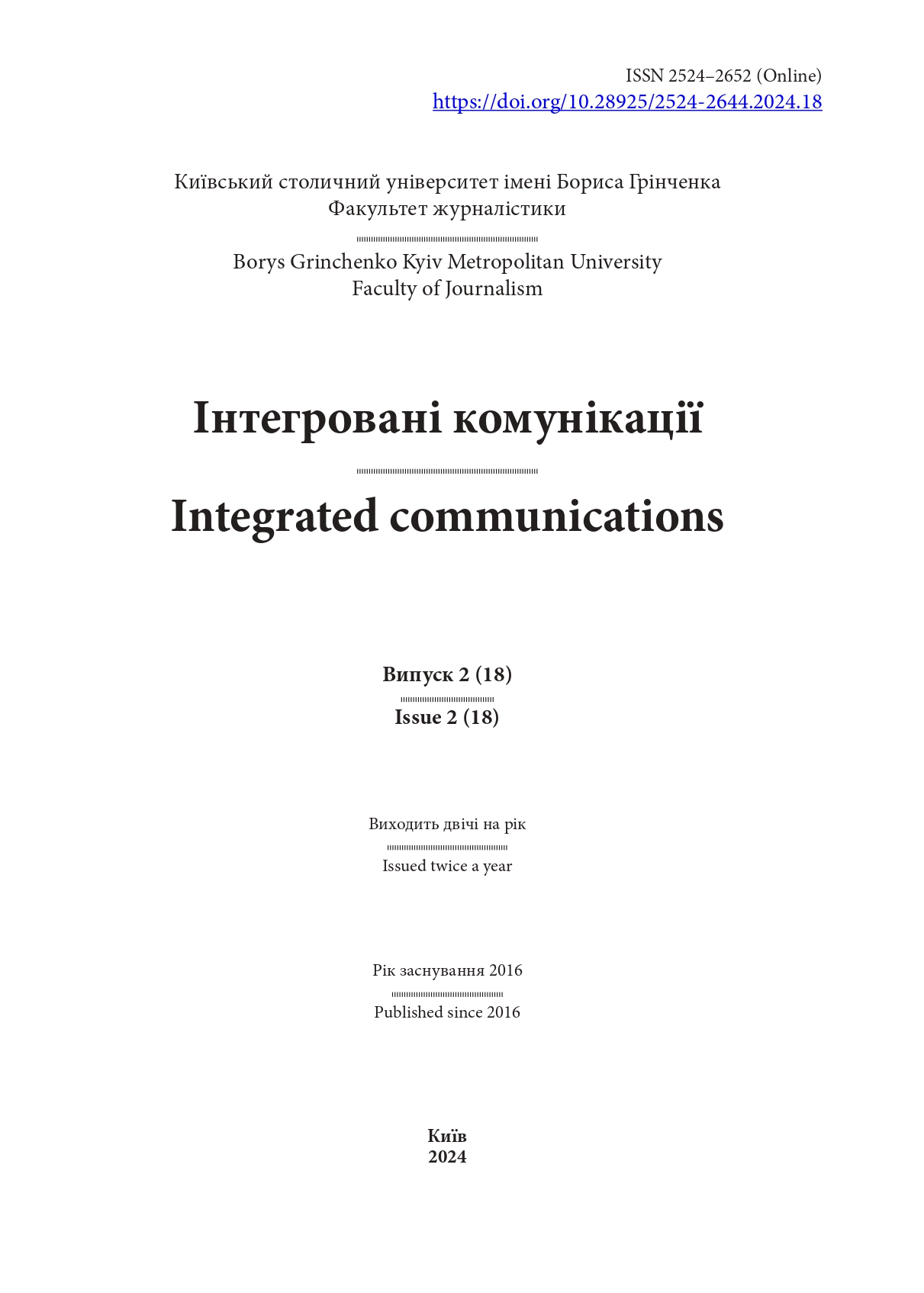A SPOKESPERSON IN THE DIGITAL AGE: TRANSFORMATION, CHALLENGES AND OPPORTUNITIES
Abstract
The study aims to explore the transformation of the role of the spokesperson in the digital age due to the expansion of the spokesperson’s scope of activities as a result of personal interaction with the public, the need to manage modern digital platforms, ensure consistency of messages and adapt to the new format and speed of news dissemination.
The article analyses the challenges that spokespersons face in the information space today, identifies the communication opportunities that spokespersons face in connection with the integration of digital platforms, and tracks the activities of the spokesperson for the President of the European Council, Ecaterine Casinge in terms of her activity on platform X to position the spokesperson and establish mutual understanding with the public.
To deepen the understanding of the role of the spokesperson in the modern information space, the authors used such research methods as statistical analytics, in particular, the content analysis method, to systematize and cover the spokesperson’s messages on a digital platform, such as a sample of the official account of the institution’s spokesperson on a social network. The content included press releases, social media posts, live video messages, and public engagement. The empirical basis of the study is the content of the social platform X from June 2023 to September 2024 by the spokesperson for the President of the European Council, Ecaterine Casinge.
The effectiveness of the spokesperson’s communication strategy was studied, which gave an idea of the level of audience coverage and interaction of the content with the public. The study provides quantitative indicators of the involvement of the target audience of Ecaterine Casinge to assess the effectiveness of her communication activities. It has been found that the spokesperson ensures that her messages are conveyed to the public through retweets of information materials.
The results of this study should be used to outline the future role of the spokesperson in the context of integrating artificial intelligence and virtual and augmented reality. The spokesperson of the future must balance new digital capabilities with the needs of the audience and act in a transparent, reliable and authoritative way.
Downloads
References
Bebyk, V. (2005). Informacijno-komunikacijnyj menedzhment u globalnomu suspilstvi: Psyhologiya, tehnologiyi, tehnika pablik rylejshnz [Information and communication management in global society: Psychology, technology, public relations technique]. MAUP.
Bilan, N. I., & Netreba, M. M. (2022). Informacijno-analitychna diyalnist pressluzhb agrarnoyi galuzi Ukrayiny [Informational and analytical activities of press services of the agrarian industry of Ukraine]. Navchalno-naukovyj instytut zhurnalistyky. Retrieved from http://journlib.univ.kiev.ua/navch/agroinf.pdf
Danylenko, S. I. (2006). Pres-sluzhba: Osnovy organizaciyi ta diyalnosti [Press service: Basics of organization and activity]. IMV.
Kruglyak, A. V., & Shevchenko, L. Yu. (2016). Osoblyvosti funkcionuvannya pres-centriv yak skladovoyi socialno-komunikacijnoyi diyalnosti vyshchyh navchalnyh zakladiv Ukrayiny ta Polshchi (na prykladi Kyivskogo nacionalnogo universytetu imeni Tarasa Shevchenka ta Universytetu imeni Adama Mickevycha u Poznani) [Peculiarities of the functioning of press centers as a component of social and communication activities of higher educational institutions of Ukraine and Poland (on the example of Kyiv National University named after Taras Shevchenko and Adam Mickiewicz University in Poznan)]. Molodyj vchenyj, 6, 329–332.
Semak, B. B., Basij, N. F., & Bojchuk, I. V. (2018). Rol pres-sluzhb v organizaciyi roboty organiv derzhavnoyi vlady [The role of press services in organizing the work of state authorities]. Visnyk Lvivskogo torgovelno-ekonomichnogo universytetu. Ekonomichni nauky, 56, 72–77.
Fylypchuk, S. V. (2017). Rol providnyh rechnykiv u socialnyh komunikaciyah pravoslavnyh ta greko-katolykiv suchasnoyi Ukrayiny [The role of leading spokespersons in the social communications of Orthodox and Greek Catholics of modern Ukraine]. Gumanitarnyj visnyk Zaporizkoyi derzhavnoyi inzhenernoyi akademiyi, 71, 97–106.
Carlson, M., Robinson, S., & Lewis, S. (2020). Digital press criticism: The symbolic dimensions of Donald Trump’s assault on U.S. journalists as the "enemy of the people". Digital Journalism, 9, 737–754. https://doi.org/10.1080/21670811.2020.1836981
Chadwick, A. (2017). The hybrid media system: Politics and power. Oxford University Press. https://doi.org/10.1093/oso/9780190696726.001.0001
Constantin, A., & Petrucă, I. (2019). The role of the spokesperson in the process of public relations. International Journal of Communication Research, 9(3), 261–265. https://bit.ly/3Kjyr11
Cook, T. (1988). Press secretaries and media strategies in the House of Representatives: Deciding whom to pursue. American Journal of Political Science, 32, 211–1200. https://doi.org/10.2307/2111200
Graber, D. A., & Smith, J. M. (2005). Political communication faces the 21st century. Journal of Communication, 55. https://doi.org/10.1111/j.1460-2466.2005.tb02682.x
Kumar, M. (2001). The office of the press secretary. Presidential Studies Quarterly, 31, 296–322. https://doi.org/10.1111/J.0360-4918.2001.00172.X
McNair, B. (2006). Cultural chaos: Journalism, news, and power in a globalised world. Routledge. Retrieved from http://www.loc.gov/catdir/toc/ecip061/2005029925.html
Milojevic, A. (2015). The two-way symmetrical public relations and digital communication technologies: Between theory and praxis. CM: Communication and Media Journal, 35, 81–108. https://doi.org/10.5937/comman10-9929
Shuwen, Y. (2011). Network spokesman: The new role of communication between the government and the public. In Y. Shuwen (Ed.), Proceedings of the 2011 International Conference on Communication (pp. 157–164). https://doi.org/10.1007/978-3-642-25188-7_19
Towle, M. (1997). On behalf of the president: Four factors affecting the success of the presidential press secretary. Presidential Studies Quarterly, 27, 297–320.
Troester, R. (1991). The corporate spokesperson in external organizational communication. Management Communication Quarterly, 4, 528–540. https://doi.org/10.1177/0893318991004004006




